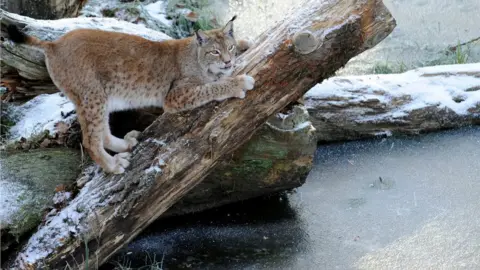Eurasian lynx: Plan to return it to Kielder Forest to be submitted
 Getty Images
Getty ImagesPlans to reintroduce the Eurasian lynx 1,300 years after it became extinct in the UK will be submitted soon, campaigners have said.
The Lynx UK Trust wants to import up to six of the cats from Sweden to Kielder Forest in Northumberland.
With a public consultation over, the trust said the five year trial plan would go to Natural England by September.
It has been criticised by some residents and sheep farmers.
 Getty Images
Getty ImagesThe scheme would see four to six lynx wearing radio tracking devices with Kielder chosen due to its dense woodland and low number of roads.
The trust said the animals would help control deer numbers as well provide a tourism boost.
Dr Paul O'Donoghue from the trust told the Guardian the lynx "belongs here" and is an "intrinsic part of the the UK environment".
He also told the paper he hoped the lynx could be in the forest by the end of the year.
Sheep farmers fear the animals could target their livestock although the trust said the cats would hunt in woods rather than fields.
The trust did admit, however, that some sheep could be killed but farmers would be "generously compensated" for any losses.
'Unnecessary pain'
Phil Stocker, chief executive of the National Sheep Association, said there were several hundred sheep farmers around Kielder, any one of whom could be affected by the lynx.
He said valuing a sheep was complex and, money aside, there were major welfare concerns.
Mr Stocker said people would not accept animals facing "unnecessary pain" and one sheep being attacked by a lynx could cause major stress and possible damage to others in the flock.
He said the UK no longer had the "landscape" for the lynx to be "genetically sustainable" and it would not be in the cat's interest to be reintroduced into an environment that, thanks to roads and industry, has changed so much since the cat existed here.
